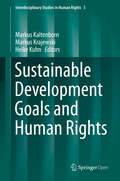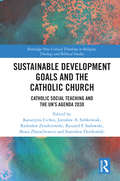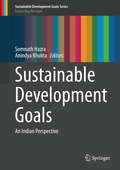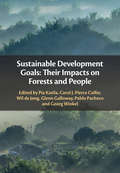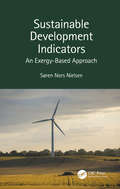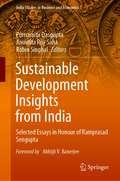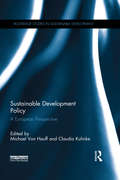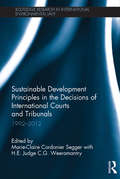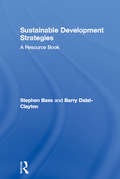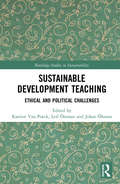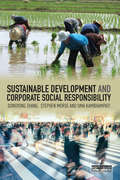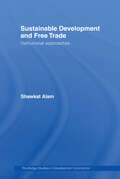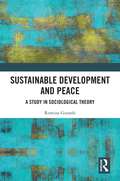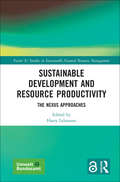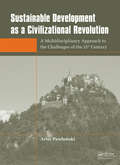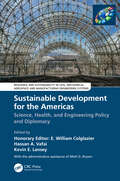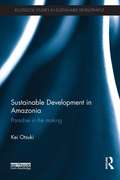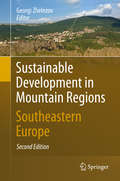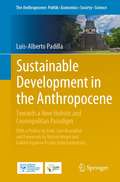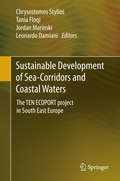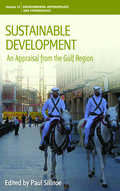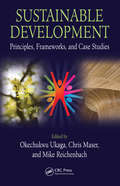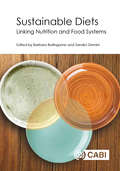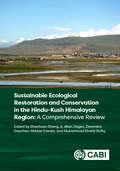- Table View
- List View
Sustainable Development Goals and Human Rights (Interdisciplinary Studies in Human Rights #5)
by Markus Krajewski Markus Kaltenborn Heike KuhnThis open access book analyses the interplay of sustainable development and human rights from different perspectives including fight against poverty, health, gender equality, working conditions, climate change and the role of private actors. Each aspect is addressed from a more human rights-focused angle and a development-policy angle. This allows comparisons between the different approaches but also seeks to close gaps which would remain if only one perspective would be at the center of the discussions. Specifically, the book shows the strong connections between human rights and the objectives of the 2030 Agenda for Sustainable Development and the Sustainable Development Goals adopted by the United Nations in 2015. Already the preamble of this document explicitly states that “the 17 Sustainable Development Goals ... seek to realise the human rights of all”. Moreover, several goals and targets of the 2030 Agenda correspond to already existing individual human rights obligations. The contributions of this volume therefore also address how the implementation of human rights and SDGs can reinforce each other, but also point to critical shortcomings of the different approaches.
Sustainable Development Goals and the Catholic Church: Catholic Social Teaching and the UN’s Agenda 2030 (Routledge New Critical Thinking in Religion, Theology and Biblical Studies)
by Ski Katarzyna Cichos Stanis 322 Jaros 322 Aw A. Sobkowiak Ryszard F. Sadowski Beata Zbarachewicz Rados 322 Aw Zenderowski Aw Dzieko 324This book identifies both the consistencies and disparities between Catholic Social Teaching and the United Nation’s (UN) Sustainable Development Goals (SDGs). With Pope Francis’ Laudato si’ encyclical, Catholicism seems to be engaging more than ever with environmental and developmental concerns. However, there remains the question of how these theological statements will be put into practice. The ongoing involvement of the Catholic Church in social matters makes it a significant potential partner in issues around development. Therefore, with the use of the comparative method, this book brings together authors from multiple disciplines to assess how the political and legal aspects of each of the UN’s 17 SDGs are addressed by Catholic Social Teaching. Chapters answer the question of how the Catholic Church evaluates the concept of sustainable development as defined by the Agenda 2030 Goals, as well as assessing how and if it can contribute to shaping the contemporary concept of global development. Examining the potential level of cooperation between the international community and the Catholic Church in the implementation of the Agenda 2030 Goals, this volume will be of keen interest to scholars of Catholic Studies, Religious Studies and the Sociology of Religion, as well as Environmental Studies and Development Studies.
Sustainable Development Goals: An Indian Perspective (Sustainable Development Goals Series)
by Somnath Hazra Anindya BhuktaThis volume examines the practicality of achieving the UN Sustainable Development Goals in India, and includes policy analyses and statistical assessments of comparative data between India and different countries. With a focus on poverty and economics, the contributors offer sector and state specific performance analyses of each goal, determining the feasibility for different states and regions to implement a given goal under conditions of extreme poverty and economic distress. Readers will learn how to perform comprehensive economic performance analyses, and how to apply these methods at local and regional scales within the framework of sustainable development. The book will be of interest to students and researchers studying sustainable development, economics, and policy analysis, as well as NGOs and government agencies working towards achieving the SDGs in impoverished nations.
Sustainable Development Goals: Their Impacts on Forests and People
by Carol J. De Jong Pia Katila Pierce Colfer Wil Glenn Galloway Pablo Pacheco Georg WinkelForests provide vital ecosystem services crucial to human well-being and sustainable development, and have an important role to play in achieving the seventeen Sustainable Development Goals (SDGs) of the United Nations 2030 Agenda. Little attention, however, has yet focused on how efforts to achieve the SDGs will impact forests and forest-related livelihoods, and how these impacts may, in turn, enhance or undermine the contributions of forests to climate and development. This book discusses the conditions that influence how SDGs are implemented and prioritised, and provides a systematic, multidisciplinary global assessment of interlinkages among the SDGs and their targets, increasing understanding of potential synergies and unavoidable trade-offs between goals. Ideal for academic researchers, students and decision-makers interested in sustainable development in the context of forests, this book will provide invaluable knowledge for efforts undertaken to reach the SDGs. This title is available as Open Access via Cambridge Core.
Sustainable Development Indicators: An Exergy-Based Approach (Applied Ecology and Environmental Management)
by Søren Nors NielsenAnalyzing the self-sufficient Danish island of Samsø, this book explains sustainability through a bio-geophysical understanding of how to best use society’s limited resources to achieve true sustainability. The method used derives from the thermodynamic function of exergy. By analyzing exergy flows and establishing a system for evaluating the energy and the materials used in a society, the author creates a platform for monitoring certain indicators of sustainability. These indicators inform readers about the actions that must be taken and the time frames for achieving sustainability goals. The exergy-based approach is an important tool for carrying out such an analysis because it Focuses on several key thermodynamic concepts and the usefulness of exergy analysis for evaluating sustainability Explains sustainability by implementing thermodynamic laws to societal consumption and the use of resources Discusses new methods that integrate energy and material fluxes and evaluates them against each other Provides direct indicators for finding the largest problems/obstacles and deciding where measures should be taken Includes instructions on how to establish an accounting system for evaluating the energy and the materials used in a society This book is aimed for professionals, researchers, and students working on nature conservation and environmental management projects related to sustainability.
Sustainable Development Insights from India: Selected Essays in Honour of Ramprasad Sengupta (India Studies in Business and Economics)
by Purnamita Dasgupta Anindita Roy Saha Robin SinghalThis volume is a collection of essays that provide a comprehensive coverage of multiple aspects of the discourse on environment, development and sustainability. It is designed to bring in a host of perspectives highlighting the synergies and the trade-offs in this debate, showcasing research along with policy implications of putting research into use.The global discussion on sustainability paints the broad canvas for this book. This volume aims to probe some contemporary issues that will help in understanding the sustainability narrative in India. The topics span over a host of questions on energy, environment, natural resources and related constituents of development. The discourse further extends to the role of economic modelling, public policy debates, political intervention, stakeholders’ response, community participation and so on. The discussions are often based on empirical support, review of existing literature as well as policy analysis. With an ultimate aim to understand the overall development narrative of the people of India, the discourse takes in its ambit the nuances of resource utilisation, economic growth, COVID-19 impacts, competitiveness and market structures, urbanization, sectoral reforms, environmental hazards, climate change, pollution, natural resource accounting and management to name a few.The book is divided into four sections, namely, The Big Picture: Evolving Perspectives; The Energy Scenario: Dilemmas and Opportunities; Sustainability Cross-Cuts: Developmental Aspects and Externality Empirics: Knowledge and Practice. The first section contains commentaries on the overarching themes of economic growth, development and sustainability. It presents some emerging perspectives on the developmental crisis that has emerged through the environmental lens with additional focus on the need for inclusion of creativity, knowhow, technology and financial resources to achieve the ambitious SDG targets. The second section brings out the dilemmas and opportunities in the energy sector, that has been a key player in discussions of sustainability, especially for India where significant technological advances in conventional forms of energy supply coexists with fairly low levels of per capita energy consumption and energy security is a key challenge. The section on sustainability crosscuts attempts to highlight the problems and processes of mainstreaming the sustainability question into conventional thinking through the concepts of a circular economy, green accounting techniques, institutional and governance structures, public policy and inclusive growth, amongst others. The last section presents some empirical studies on environmental externalities, the unaccounted environmental effects of economic production and consumption and finally the behavioural aspects of the stakeholders that are crucial in the larger narrative of sustainable development.This edited volume contains contributions of reputed scholars from various Indian universities, research institutions and professionals from outside academia, who are proven experts in their fields. The link between policy, practice, and well-being of the large vulnerable population of India is the major focus of enquiry that will help researchers, practitioners and policy planners in conducting further research in energy, environment, resource and linked areas of development economics. General readers with an active interest in energy, environment, and economic development are also likely to find this book an interesting read, especially in the times of several environmental challenges facing humankind.
Sustainable Development Policy: A European Perspective (Routledge Studies in Sustainable Development)
by Michael Von Hauff Claudia KuhnkeSustainable Development Policy: A European Perspective uses a variety of multidisciplinary perspectives to explore the ways in which sustainable infrastructures can play a more prominent and effective role in international development policy. Building on a solid introduction to sustainability and development policy, this book discusses ways in which viable reform can be promoted through coherent governing, the design of social security systems, education systems and the possibilities of fair trade as an alternative trading concept . Sustainable Development Policy generates a platform on which to encourage constructive dialogue on issues surrounding sustainability in the wake of the global scarcity of natural and economic resources. This edited collection will be of great interest to all students and lecturers of development studies and development policy, as well as researchers from other disciplines looking for an introduction to sustainable development policy and its practical applications.
Sustainable Development Principles in the Decisions of International Courts and Tribunals: 1992-2012 (Routledge Research in International Environmental Law)
by Marie-Claire Cordonier Segger Judge C.G. WeeramantryThe 2002 New Delhi Declaration of Principles of International Law relating to Sustainable Development set out seven principles on sustainable development, as agreed in treaties and soft-law instruments from before the 1992 Rio ‘Earth Summit’ UNCED, to the 2002 Johannesburg World Summit on Sustainable Development, to the 2012 Rio UNCSD. Recognition of the New Delhi principles is shaping the decisions of dispute settlement bodies with jurisdiction over many subjects: the environment, human rights, trade, investment, and crime, among others. This book explores the expanding international jurisprudence incorporating principles of international law on sustainable development. Through chapters by respected experts, the volume documents the application and interpretation of these principles, demonstrating how courts and tribunals are contributing to the world’s Sustainable Development Goals, by peacefully resolving disputes. It charts the evolution of these principles in international law from soft law standards towards recognition as customary law in certain instances, assessing key challenges to further judicial consideration of the principles, and discussing, for instance, how their relevance for compliance and disputes related to the 2015 Paris Agreement on climate change. The volume provides a unique contribution of great interest to law and policy-makers, judges, academics, students, civil society and practitioners concerned with sustainable development and the law, globally.
Sustainable Development Strategies: A Resource Book
by Barry Dalal-Clayton Stephen BassThis book is a cornerstone resource for a wide range of organizations and individuals concerned with sustainable development at national or local levels, as well as for international organizations concerned with supporting such development. Whilst the focus is on integrated strategies for sustainable development, the approaches and methods covered are equally relevant to poverty reduction, environmental and sectoral strategies, programme development and review. Agenda 21 called for all countries to develop sustainable development strategies. For such strategies to be effective there needs to be a real commitment. In every country, government at all levels, the private sector, and civil society, must work together in a true partnership, in transparent ways which enable genuine stakeholder participation. The necessary mechanisms and processes need to be coordinated to enable continuous learning and improvement. This resource book provides flexible, non-prescriptive guidance on how to develop, assess and implement national sustainable development strategies. It sets out principles and ideas on process and methods, and suggests how these can be used. It is based on an analysis of past and current practice, drawing directly from experience in both developed and developing countries. Following a discussion of the nature and challenges of sustainable development and the need for strategic responses to them, the heart of the book covers the main tasks in strategy processes. Individual chapters offer a rich range of guidance, ideas and case studies.
Sustainable Development Teaching: Ethical and Political Challenges (Routledge Studies in Sustainability)
by Leif Östman Katrien Van Poeck Johan ÖhmanThe aim of this book is to support and inspire teachers to contribute to much-needed processes of sustainable development and to develop teaching practices and professional identities that allow them to cope with the specificity of sustainability issues and, in particular, with the teaching challenges related to the ethical and political dimension of environmental and sustainability education. Bringing together recent scholarship on the topic, this book translates state-of-the-art academic research into teaching models, methods and tools. Starting with an outline of the challenge of sustainability, it offers insights and models for understanding the interesting yet ambiguous concept of ‘sustainable development’ and the complex process of transforming society in a more sustainable direction (Part I). It then goes on to provide a guide to preparing courses and lessons as well as tools for reflection about teaching practices and the multiplicity of approaches to addressing ethical and political challenges in sustainable development teaching (Part II). Finally, the book offers useful conceptual frameworks, models and typologies about the concrete design and implementation of sustainable development teaching (Part III). This book will be essential reading for students of education, as well as teachers in compulsory and higher education and sustainability education researchers.
Sustainable Development and Corporate Social Responsibility
by Stephen Morse Dongyong Zhang Uma KambhampatiCorporate Social Responsibility (CSR) has become an important concept in the last few decades. Although it originated in the developed countries of the West, the concept has been embraced and adapted by corporations and policy-making agencies in many developing countries. Not surprisingly, given the importance of growth and development as policy objectives in these countries, CSR has had a significant impact on sustainable development. Sustainable Development and Corporate Social Responsibility explores the evolution of CSR across the developed and developing world, with a particular focus on China and sustainable development. Through an extensive review of the literature and relevant case studies, the book examines whether CSR can make a contribution to sustainable development, how the patterns of CSR in developed Western economies compare to that in the rapidly growing economy of China, what trade-offs take place between CSR and economic growth as well as the future of CSR and its possible impact on the global sustainable development agenda. This book is a valuable resource for academics and upper-level undergraduate and postgraduate students in the fields of human/social geography, economics, business studies, sustainable development, development studies and environmental studies.
Sustainable Development and Free Trade: Institutional Approaches (Routledge Studies In Development Economics Ser.)
by Shawkat AlamExamining institutions rather than themes, this critical book provides a comprehensive survey of the inter-relationship between trade-induced economic growth and the environment and its impact on the global quest for sustainable development. Focusing in particular on the interests and concerns of developing countries and the skewing of internationa
Sustainable Development and Peace: A Study in Sociological Theory
by Romina GurashiThis book explores the growing attention that sociology has started to give to environmental issues in terms of peace and social justice. With a focus on sociological theory and its development, it reconstructs the long journey made by the social sciences towards the reconstruction, in a single theoretical paradigm, of the problems associated with the implementation of conditions of peace and sustainability. Beginning from the premise that environmental issues are never purely environmental, but entail political, economic and social implications, Sustainable Development and Peace offers an understanding of where we are heading and how, reflecting on present challenges and possible directions for the future. It will, therefore, appeal to scholars of sociology, social theory, development studies, politics and environmental studies.
Sustainable Development and Resource Productivity: The Nexus Approaches (Factor X: Studies in Sustainable Natural Resource Management)
by Harry LehmannThe fourth Factor X publication from the German Environment Agency (Umweltbundesamt, UBA), Sustainable Development and Resource Productivity: The Nexus Approaches explores the interdependencies of sustainable development paths and associated resource requirements, describing and analysing the necessities for a more resource efficient world. The use of and competition for increasingly scarce resources are growing worldwide with current production and consumption patterns of industrialised economies soon to reach the point where the ecosphere will be overtaxed far beyond its limits. Against this background, this volume examines the important initiatives to monitor resource use at the international, EU and national level. The current trends and challenges related to sustainable resource use are discussed, including international challenges for a resource efficient world, megatrends, justice and equitable access to resources. In the second part of the book, contributions examine implementation strategies. They assess the concept known as circular economy and discuss the theory of growth and the role of the financial and education systems. The final section places special emphasis on practical examples. Overall, the book presents concrete ways and examples of achieving more sustainability in practice. Discussing solutions for a more sustainable use of natural resources, this book is essential reading for scholars and students of natural resources and sustainable development and decision-makers and experts from the fields of policy development, industry and civil society.
Sustainable Development as a Civilizational Revolution: A Multidisciplinary Approach to the Challenges of the 21st Century
by Artur PawlowskiAs a concept, sustainable development is in conflict with traditional development based upon economic growth. Sustainable development is an attempt to formulate a programme that integrates different aspects (ecological, social, and economical) which were usually considered as separate from each other. Sustainable Development as a Civilizationa
Sustainable Development for the Americas: Science, Health, and Engineering Policy and Diplomacy (Resilience and Sustainability in Civil, Mechanical, Aerospace and Manufacturing Engineering Systems)
by E. William ColglazierEnvironmental sustainability efforts require a great deal of engagement and political will, ranging from local communities to state departments. Science diplomats—from experts and scientists to spokespersons and ambassadors—can help facilitate at all levels and yield valued resources from technology sharing, capacity building, and knowledge exchanges. This book explores the importance of sustained international scientific cooperation, building community resilience, and the role of political will in sustainability and diplomacy. It shows how even small diplomatic efforts can influence myriad issues, from overfishing to human rights negotiations to global carbon emission reduction. Features: • Examines various topics such as global climate change, arid environments, water security and governance, trans-boundary conflict and cooperation, urban and rural resilience, and public health. • Presents case studies from various geographic regions through the lens of diplomacy, including the US–Mexico border, the Gulf of California, South America, Europe, the Middle East, Central and South Asia, and China. • Discusses how building networks of people, organizations, and countries engaged in science diplomacy is crucial for mutual growth and for overcoming conflicting political stances. Sustainable Development for the Americas: Science, Health and Engineering Policy and Diplomacy provides a useful resource for diplomats, policymakers, students, and decision-makers. It provides numerous examples of how using science and technology for policy and diplomacy is essential to finding common ground among nations for a collective global benefit.
Sustainable Development in Amazonia: Paradise in the Making (Routledge Studies in Sustainable Development)
by Kei OtsukiThis book argues against the assumption that sustainability and environmental conservation are naturally the common goal and norm for everyone in Amazonia. This is the first book focusing on agency, reflexivity and social development to address sustainable development in the region. It discusses the importance of looking into societal dynamics in order to deal with deforestation and sustainable development policies through the ethnography of an Amazonian settlement named New Paradise. This book demystifies utopian and overtly conservationist views that depict the Amazon rainforest as a troubled paradise. Engaging with social theory of practice with particular focus on emergentist perspectives and Foucault’s analysis of ‘heterotopia’, the author shows that Amazonia is a set of settlement heterotopias in which various local and external initiatives interact to make up real, lived-in places. The settlers’ placemaking continually rearranges power and material relations while the process usually emphasises utopian developmentalist and conservationist policy intervention. This book explores in detail how, as power relations are arranged and governance reshaped, sustainable development and construction of a green society also need to become a goal for the settlers themselves. The book’s insights on the relationship between the sustainable development frameworks used in environmental policy, and ongoing societal development on the ground inform debate both within Amazonia, and in comparable communities worldwide. It also offers institutional pathways to realise new, more engaging, policy intervention for development professionals and policy makers.
Sustainable Development in Mountain Regions
by Georgi ZhelezovThe mountain regions in Southeastern Europe are unique natural regions of great beauty and ecological value, and home of the head waters of major rivers. They constitute a major ecological, economic, cultural, recreational and living environment in Europe, shared by numerous cultures and countries. The Southeastern European Mountain Regions are an important reservoir for biodiversity and habitats in Europe. A great number of protected areas - national parks, nature parks, reserves and nature monuments are located in these regions. From a socio-economic point of view the mountain regions are among the poorest areas in the Southeastern European countries, but they have potential for the implementation of successful economic activities. There are opportunities for development of these regions and, in particular, for trans-border integration and co-operation. This book brings together research results from experts from all Balkan countries working on the problems of the mountain regions in Southeastern Europe. The volume focuses on the challenges taking place along the rapid transformation in land use, biodiversity, tourism, nature risk and bio-productivity due to the global changes and particularly due to the local impacts of climate change. The key questions for discussion are: - Biodiversity, nature protection and conservation - Natural disasters and risk management - Social-economical development of the mountain regions - Spatial planning in the development of the mountain regions - Sustainable practices and politics for land use - Transborder co-operation.
Sustainable Development in the Anthropocene: Towards a New Holistic and Cosmopolitan Paradigm (The Anthropocene: Politik—Economics—Society—Science #29)
by Luis-Alberto PadillaIn the Anthropocene sustainable development responds to socio-economic, environmental and political crises provoked by humankind due to global warming and the great acceleration of human intervention in ecosystems. This book introduces readers to current debates on sustainable development and to a holistic and multidisciplinary approach. Regional integration and supranational institutions are fundamental for sustainable development. The democratisation of the international system requires a new multilateralism. Global problems of demography, economic ideology of unlimited growth, the prevailing technocratic paradigm, consumerism, problems of waste, fossil fuels, industrial food production, use of fertilisers, water management and climate change are discussed, and the importance of multilateral agreements for security, sustainable peace and development is explored. This planetary crisis may be solved by international cooperation based on the UN sustainable development goals.This book - provides a concise synthesis of the main subjects of sustainable development studies- links development studies to multilateral diplomacy as practised by UN bodies and organisations- gives a new holistic and multidisciplinary approach to environmental and social sciences in the Anthropocene epoch.
Sustainable Development of Sea-Corridors and Coastal Waters
by Chrysostomos Stylios Tania Floqi Jordan Marinski Leonardo DamianiEdited in collaboration with TEN ECOPORT project, this volume contains the proceedings of the 1st International Conference on 'Sustainable Development of the Sea-corridors and Coastal Waters'. The book highlights the advances of environmental pollution management on ports and coastal zones. Particular attention is given to water quality, issues that concern the marine environment of sea corridors and coastal waters, especially in regions surrounding ports. In addition to these topics the chapters explore novel methodologies and technologies, IT solutions, data and instrumentation of monitoring water quality. The book is organized into five parts: assessment, monitoring, sustainable management system, port processes and historical ports. TEN ECOPORT (Transnational ENhancement of ECOPORT8 network) is a project co-financed by the South East Europe Transnational Cooperation Programme.
Sustainable Development, International Criminal Justice, and Treaty Implementation
by Marie-Claire Cordonier Segger Sébastien JodoinInternational Criminal Justice and Sustainable Development provides a serious and timely perspective on the relationship between two important and dynamic fields of international law. Comprised of chapters written by leading academics and international lawyers, this book examines how the principles and practices of international criminal law and sustainable development can contribute to one another's elaboration, interpretation, and implementation. Chapters in the book discuss the potential and limitations of international criminalization as a means for protecting the basic foundations of sustainable development; the role of existing international crimes in penalizing serious forms of economic, social, environmental, and cultural harm; the indirect linkages that have developed between sustainable development and various mechanisms of criminal accountability and redress; and innovative proposals to broaden the scope of international criminal justice. With its rigorous and innovative arguments, this book forms a unique and urgent contribution to current debates on the future of global justice and sustainability.
Sustainable Development: An Appraisal from the Gulf Region
by Paul SillitoeWith growing evidence of unsustainable use of the world's resources, such as hydrocarbon reserves, and related environmental pollution, as in alarming climate change predictions, sustainable development is arguably the prominent issue of the 21st century. This volume gives a wide ranging introduction focusing on the arid Gulf region, where the challenges of sustainable development are starkly evident. The Gulf relies on non-renewable oil and gas exports to supply the world's insatiable CO2 emitting energy demands, and has built unsustainable conurbations with water supplies dependent on energy hungry desalination plants and deep aquifers pumped beyond natural replenishment rates. Sustainable Development has an interdisciplinary focus, bringing together university faculty and government personnel from the Gulf, Europe, and North America -- including social and natural scientists, environmentalists and economists, architects and planners -- to discuss topics such as sustainable natural resource use and urbanization, industrial and technological development, economy and politics, history and geography.
Sustainable Development: Principles, Frameworks, and Case Studies
by Chris Maser Okechukwu Ukaga Mike ReichenbachCoined in the 1970s, the term sustainable development and the ideas behind it have enjoyed varying amounts of popularity over the years. And while dire predictions abound, the full impacts of global warming are not known, nor can they be known. What we do know is that to be sustainable, all societies must adjust to new realities, which include chan
Sustainable Diets: Directions And Solutions For Policy, Research And Action
by Barbara Burlingame Sandro DerniniThis book takes a transdisciplinary approach and considers multisectoral actions, integrating health, agriculture and environmental issues to comprehensively explore the topic of sustainable diets. The team of international authors informs readers with arguments, challenges, perspectives, policies, actions and solutions on global topics that must be properly understood in order to be effectively addressed. They position issues of sustainable diets as central to the Earth's future. Presenting the latest findings, they: <P><P> - Explore the transition to sustainable diets within the context of sustainable food systems, addressing the right to food, and linking food security and nutrition to sustainability; <P><P> - Convey the urgency of coordinated action, and consider how to engage multiple sectors in dialogue and joint research to tackle the pressing problems that have taken us to the edge, and beyond, of the planet's limits to growth; <P><P> - Review tools, methods and indicators for assessing sustainable diets; <P><P> - Describe lessons learned from case studies on both traditional food systems and current dietary challenges. <P><P> As an affiliated project of the 10YFP Sustainable Food Systems Program, this book provides a way forward for achieving global and local targets, including the Sustainable Development Goals and the United Nations Decade of Action on Nutrition commitments. This resource is essential reading for scientists, practitioners and students in the fields of nutrition science, food science, environmental science, agricultural science, development studies, food studies, public health and food policy.
Sustainable Ecological Restoration and Conservation in the Hindu Kush Himalayan Region: A Comprehensive Review
by Professor Zhanhuan Shang Professor Allan Degen Dr Devendra Gauchan Professor Madan Koirala Dr Muhammad Khalid RafiqThe years 2021 to 2030 have been designated as "The United Nations Decade on Ecosystem Restoration". Ecological restoration and biodiversity conservation efforts face unprecedented challenges, especially in developing countries and areas, such as the Hindu Kush-Himalayan (HKH) region. This huge HKH region, which includes areas in eight separate countries (Afghanistan, Pakistan, Nepal, India, China, Bangladesh, Myanmar and Bhutan), is a biodiversity hotspot with a vast array of ecosystems, landscapes, peoples and cultures. It is known as one of 'the pulses of the world'. However, the HKH is also the world's largest and poorest mountain region, where landscapes and environments have been severely damaged as a result of climate change and human activities. Coordinating conservation and restoration policies, sharing knowledge and funds, and maintaining livelihoods are major challenges and are in urgent need of improvement. This book details the past and current ecological problems in the HKH region, and the threats and challenges that ecosystems and local people face. It pays special attention to developments of transformative adaptations and presents examples of sustainable conservation and ecological restoration management practices. Three primary questions are addressed: (1) Do the existing conservation strategies of international organizations and government policies really protect ecosystems and solve biodiversity problems? (2) Can these management measures be one-time solutions? and (3) What is the strategic framework and scenario prognosis for the future based on the historical trajectory of ecological conservation and restoration in the region? This book is essential reading for ecologists and conservation biologists involved in large-scale ecological restoration projects, along with practitioners, graduate students, policy makers and international development workers.
